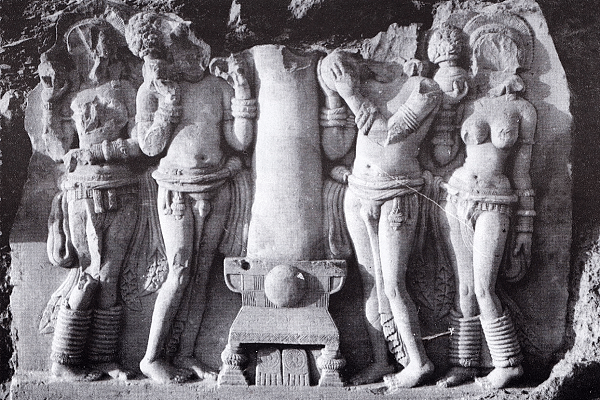
The Chandavaram Loot – How Andhra Pradesh Is Missing An Opportunity To Go After Heritage Smugglers
It has been two years since the heritage artefacts from the Chandavaram site in Andhra Pradesh that had been stolen over a decade and a half ago were returned to India by Australia. But no effort has been made to pin down those who smuggled these and many other pieces of heritage.
For the uninitiated, Chandavaram in Andhra Pradesh’s Prakasam district does not ring a bell. But for those deeply engaged with India’s past, the village is of considerable importance. It is here that archaeologists in the 1960s discovered a more than two thousand years old heritage site with the remains of many stupas, Chaityas and Viharas. The Buddhist site is thought to have been flourishing during the Satavahana dynasty era, an ancient dynasty that controlled large parts of the Deccan plateau during the first century BCE to the second century BCE.
It was also here that one of India’s most incredible heritage thefts happened.
In July 2001, media carried news about the series of thefts at important archaeological sites in Andhra Pradesh – especially the 2000-year-old Buddhist sites in and around Chandavaram. An organised gang had been at work and struck the same site museum three times and stolen the artefacts.
The first time they struck on 9 October 2000, “two impressive 9-ft-long panels, one with an engraving of the Bodhi tree and the other of the Chaitra or Buddhist umbrella, were yanked off the cement platform on which they were fixed and carried away from the two-room site museum at the foot of the strikingly large stupa at Chandavaram in Prakasam district.”
This did grab the attention of the authorities which saw some protection measures being taken. But then the thieves struck again on 2 February 2001 and, “…took away three exquisite pillars, each 9-ft long, including one in which the Buddha is represented as fire. The gang came in a tractor, tied up the two watchmen and decamped with the booty.”
"This was shocking for the artefacts were safe in the site museum for more than 15 years," admits Andhra Pradesh Commissioner for Archaeology and Museums A Ramalakshman, who then decided to shift the collection to a safer place in the heart of Chandavaram village, more than 3 km away.
But before the authorities could get their act together, on 23 March 2001 the gang executed their third theft when the police constables at the museum were away for lunch and took away “three more ornate pillars and a lotus medallion in a daring daylight heist.”
What happened to these artefacts?
Of the many valuable artefacts stolen from Chandavaram only a single piece - a beautiful “Buddhist panel” has been restituted from an Australian museum. It is more than a decade since the artefact made its way to the National Gallery of Australia which purchased it for USD 595,000.
A fake provenance certificate for the artefact was provided by Art of Past (Subhash Kapoor, a well-known art dealer now being prosecuted for large-scale smuggling) listed as Uttam Singh & Sons; a shop in Delhi whose letterheads were forged by Art of Past.
There is another letter of provenance for the same object from Dalhousie Enterprises which was run by Paramspry who was Kapoor’s girlfriend before they had a public spat and split.
The India Pride Project along with renowned journalists Jason Felch and Michaela Boland had exposed the fake provenance with the “robber offering photos”(photos posted by smugglers) of the artefact following which the artefact was returned.
However, despite being able to demonstrate the fake provenance India Pride Project had not known back then that the Buddhist relief was from Chandavaram site.
We learnt that the artefact was stolen from Chandavaram only when the Ministry of External Affairs had issued a routine statement about restitution of artefacts from Australia. The statement contained a brief sentence that said this artefact had been “unearthed in the 1970s during the excavation of a Buddhist stupa at Chandavaram (District. Prakasham) in Andhra Pradesh.”
It has been nearly two years since the Buddhist panel has been brought back from Australia, arguably with the help of India Pride Project’s investigations. One would assume that the Andhra state or the archaeological departments would have done something about pursuing Subhash Kapoor for tracing the other artefacts that had been stolen from Chandavaram. However, most, unfortunately, and to the best of our knowledge, till October 2018 no such attempt has been made by the department to go after Subhash Kapoor’s operations to find out if the same gang was behind the Chandavaram loot.
This despite evidence showing Kapoor having sold artefacts with similar origins to the Asian Civilisations Museum Singapore and the newly opened Louvre Abu Dhabi.
We have also tracked a few sales of the Wiener Galleries and auctions houses which seem questionable.
Meanwhile, Kapoor is held as an undertrial in Tamil Nadu. But Andhra Pradesh Police don’t seem to have any intention of filing any charges on him for at least one clear open and shut case. There are similar such cases of artefacts stolen from site museums and sites in other states of India. But the custodians do not seem keen to go after the networks.